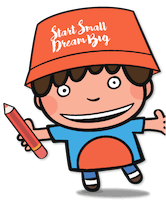Discussing about the visually handicapped
Children were greeted by a personnel from the Singapore Association for the Visually Handicapped (SAVH), Ms Delores.Ms Delores were invited to our centre to share more about ...
Confident Child, Competent Mind
“Confident Child, Competent Mind” is the core vision of PCF Sembawang Blk 755. The principal of the school, Ms Yogeswari Raghavan explained: “What we want to do is to build children's confidence. When they are confident, they will try anything. When they try, they will learn and achieve. Confidence leads to learning,”
The school successfully build confidence in many children as noticed by parents. “My child learns a lot from this school. My daughter is timid at first but upon exposure, she became more assertive and confident,” said Joy. Another parent, Celine said: “My child likes the dramatic corner in class. He has become more talkative and confident in school,”
Sritha, a mother with two children in the school, explained: “My daughter is the shy type at home. But after going to school, she improves a lot, both in her confidence and academics. We can see that there is a difference,”
The school also emphasises on core moral values such as perseverance, kindness, responsibility and appreciation. The teachers reward the children badges every time the child displays the core values. To motivate students to behave in a certain way, the teacher will also reward the students the badge so the student will eventually display the core values.
Learning with Lego
PCF Sembawang Blk 755 differentiates itself from other schools by adopting Lego education. Lego is used as teaching tool to students. “Lego is something that children can create and enjoy. Lego helps them to be creative. There is no right or wrong answers so children will not afraid and then they will always try. Lego motivates them to do more,” said Ms Raghavan.
“Lego also help with critical thinking skills because from just pieces of blocks, they have to think deeper to create an end-product all by themselves,” Ms Yoges explained.
The teachers also become facilitators and encourage students to develop their thinking and problem solving skills. For example, after building a swimming pool with Legos, the teachers will ask the children “What happens if someone drown in the pool?” then the students have to think of answers. Lego education also integrates other learning areas; students have to write down new words they learnt after building Legos.
Jolly Phonics Programme
The school decided to adopt the Jolly Phonics Programme as it is proven to help students in reading with better identification of alphabets through sounds. Jolly Phonics lessons helps to break down difficult words and improves spelling. Jolly Phonics lessons consist of songs and jingles to capture students’ attention and allow them to remember better. “Through phonics, students learn the sounds. When they learn the sounds, they will learn the words. When they can read the words, they can read sentences. Phonics is the basic in learning a language,” said Ms Raghavan. “We can see improvements after adopting the Jolly Phonics Programme and children learn the words faster,” Ms Yoges added.
Music Toolbox Program
Besides adopting Lego education as the niche area, the school also focuses on music in education by using the Music Toolbox Programme. Students are able to learn and try out the different percussion instruments such as hand drums, wrist bells and xylophones. Different class levels will learn different instruments.
The music lessons also enable students to learn music notations, beats, rhythms, songs, music dynamics and dance choreographies. The music lessons are also integrated with other learning areas. For example, when students are singing, they are also learning new words. “Music is something that allows children to be creative and happy learners,” Ms Yoges said. “With the Music Toolbox program, children learn to take instructions better and pay more attention. Thus, the program has both elements of discipline and fun. Learning choreography also helps with children’s coordination,” Ms Yoges explained further.
Hands-on activities
The school also focuses on many hands-on activities. “By doing hands-on activities, they can remember better. By doing it, they know they can do it. We can see there is improvement,” a teacher commented.
Learning areas such as numeracy and language consists of many hands-on activities with different level of difficulties. After the students completed level 1 and felt a sense of achievement, they will feel more motivated to complete level 2 and so on. The activities also involve a buddy system where children help each other to solve the problems. This improves their interaction and communication skills.
The school also adopts computer-based learning where the school have its own program of language-based and numeracy games for the child to play. “We use computer-based learning because we believe that children should have basic computer skills since young,” said Ms Yoges.
